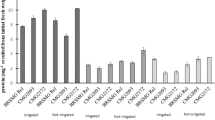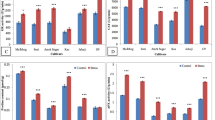Abstract
Present study was conducted to characterise ten rice genotypes based on antioxidant response. Five genotypes were adapted to transplanting conditions (PR 116, PAU 201, Punjab Mehak 1, PR 115 and PR 120) and five to aerobic conditions (Feng Ai Zan, UPLRi-7, Vandana, IR 71701-28-1-4 and MAS-946) were raised in pots for 18 days. Differential response of various antioxidative enzymes, viz., ascorbate peroxidase (APX), catalase (CAT), peroxidase (POX), glutathione reductase (GR) and contents of hydrogen peroxide (H2O2), proline, ascorbate and α-tocopherol, and levels of lipid peroxidation were estimated in shoots of genotypes. Higher activities of APX, CAT, POX, GR paralleled with higher contents of ascorbate, α-tocopherol, proline, and lower levels of lipid peroxidation and hydrogen peroxide content in cultivars adapted for transplanted conditions indicated their better scavenging ability. Cultivars PR 115, PR 120 and Feng Ai Zan performed better under aerobic conditions as revealed by higher SOD activity along with high contents of antioxidants indicating enhanced ROS scavenging ability. Our results highlights that ROS scavenging ability hold great potential in identifying and developing genotypes adapted for aerobic and transplanted conditions.


Similar content being viewed by others
References
Arnon, D. I. (1949). Copper enzymes in isolated chlorplasts, polyphenoloxidase in Beta vulgaris. Plant Physiology, 24, 1–15.
Basu, S., Roychoudhury, A., Saha, P., & Dibyendu, S. N. (2010). Differential antioxidative responses of indica rice cultivars to drought stress. Plant Growth Regulation, 60, 51–59.
Bates, H. S., Waldren, R. P., & Treane, D. (1973). Rapid estimation of free proline for water stress determination. Plant and Soil, 39, 205–207.
Becana, M., Aparicio, T. P., Irigoyan, J. J., & Sanchez, D. M. (1986). Some enzymes of hydrogen peroxide metabolism in leaves and root nodules of Medicago sativa. Plant Physiology, 82, 1169–1171.
Belder, P., Spiertz, J. H. J., Bouman, B. A. M., Lu, G., & Tuong, T. P. (2005). Nitrogen economy and water productivity of lowland rice under water-saving irrigation. Field Crops Research, 93, 169–185.
Boamah-Asare, N. K., & Fletcher, R. A. (1983). Physiological and cytological effects of BAS-9052-OH on corn (Zea mays) seedlings. Weed Science, 31, 49–52.
Esfandiari, E., Shekari, F., & Esfandiar, M. (2007). The effect of salt stress on antioxidant enzymes activity and lipid peroxidation on the wheat seedlings. Notulae Botanicae Horti Agrobotaici Cluj-Napoca, 35, 48–56.
Fang, Y., Liao, K., Du, H., Xu, Y., Song, H., Li, X., & Xiong, L. (2015). A stress-responsive NAC transcription factor SNAC3 confers heat and drought tolerance through modulation of reactive oxygen species in rice. Journal of Experimental Botany,. doi:10.1093/jxb/erv386.
Farooq, M., Siddique, K. H. M., Rehman, H., Aziz, T., Lee, D. J., & Wahid, A. (2011). Rice direct seeding: experiences, challenges and opportunities. Soil Tillage Research, 111, 87–98.
Fokar, M., Nguyen, H. T., & Blum, A. (1998). Heat tolerance in spring wheat. I. Estimating cellular thermotolerance and its heritability. Euphytica, 104, 1–8.
Goyal, M., & Asthir, B. (2010). Polyamine catabolism influences antioxidative defense mechanism in shoots and roots of five wheat genotypes under high temperature stress. Plant Growth Regulation, 60, 13–25.
Hasanuzzaman, M., Nahar, K., Alam, M., Roychowdhury, R., & Fujita, M. (2013). Physiological, biochemical, and molecular mechanisms of heat stress tolerance in plants. International Journal of Molecular Science, 14, 9643–9684.
Heath, R. L., & Packer, L. (1968). Photoperoxidation in isolated chloroplasts—Kinetics and stoichiometry of fatty acid peroxidation. Archives of Biochemistry Biophysics, 125, 189–198.
Hichem, H., Mounirb, D., & Naceurc, E. A. (2009). Differential responses of two maize (Zea mays L.) varieties to salt stress: Changes on polyphenols composition of foliage and oxidative damages. Industrial Crops Production, 30, 144–151.
Hira, C. K., Kawatra, B. L., Sadana, B., & Mann, S. K. (2001). Laboratory manual in food and nutrition. Ludhiana: Department of Food Science and Technology, Punjab Agricultural University.
Hiscox, J. D., & Israelstam, G. F. (1979). A method for the extraction of chlorophyll from leaf tissue without maceration. Canadian Journal of Botany, 57(1332), 1334.
Hsu, S., & Ching, H. K. (2003). Differential effect of sorbitol and polyethylene glycol on antioxidant enzymes in rice leaves. Plant Growth Regulation, 39, 83–90.
Huang, J., Guo, S. R., Jiang, F. L., Chen, L., & Wu, Z. (2008). Effects of shading treatment and regular light recovery on growth and reactive oxygen metabolism of pak-choi. Acta Horticulural Sinica, 35, 753–756.
Kalaji, M. H., Bosa, K., Koscielniak, J., & Hossain, Z. (2011). Chlorophyll a fluorescence—A useful tool for the early detection of temperature stress in spring barley (Hordeum vulgare L.). OMICS: A Journal of Integrative Biology, 15, 925–934.
Kato, Y., & Okami, M. (2011). Root morphology, hydraulic conductivity and plant water relations of high-yielding rice grown under aerobic conditions. Annals of Botany, 108, 575–583.
Kumar, R. R., Goswami, S., Sharma, S. K., Singh, K., Gadpayle, K. A., Kumar, N., et al. (2012). Protection against heat stress in wheat involves change in cell membrane stability, antioxidant enzymes, osmolyte, H2O2 and transcript of heat shock protein. International Journal of Plant Physiolgy and Biochemistry, 4, 83–91.
Kumari, M., Asthir, B., & Bains, N. S. (2014). Temporal dynamics of antioxidant defence system in relation to polyamine catabolism in rice raised under direct-seeded and transplanted conditions. Rice Science, 21, 343–353.
Law, M. Y., Charles, S. A., & Halliwelll, B. (1983). Glutathione and ascorbic acid in spinach (Spinach oleracea) chloroplasts: The effect of hydrogen peroxide and paraquat. Biochemical Journal, 210, 899–903.
Lee, J. G., Baek, K., Soetandyo, N., & Ye, Y. (2013). Reversible inactivation of deubiquitinases by reactive oxygen species in vitro and in cells. Nature Communications, 4, 1568–1572.
Lowry, O. H., Rosenbrough, N. J., Faar, A. L., & Randall, R. J. (1951). Protein measurement with the Folin-phenol reagent. Biological Chemistry, 183, 265–275.
Ma, J., Lv, C., Xu, M., Chen, G., Lv, C., & Gao, Z. (2015). Photosynthesis performance, antioxidant enzymes, and ultrastructural analyses of rice seedlings under chromium stress. Environmental Science Pollution Research,. doi:10.1007/s11356-015-5439-x.
Małecka, A., Derba-Maceluch, M., Kaczorowska, K., Piechalak, A., & Tomaszewska, B. (2009). Reactive oxygen species production and maceration. Canadian Journal of Botany, 57, 1332–1334.
Martin, G., James, P. P. K., & Subramanian, E. (2007). Identification on suitable rice variety adaptability to aerobic irrigation. Journal of Agricultural and Biological Sciences, 2, 1–3.
Morsy, M. R., Jouve, L., Hausman, J., Hoffmann, L., & Stewart, J. M. D. (2007). Alteration of oxidative and carbohydrate metabolism under abiotic stress in tworice (Oryza sativa L.) genotypes contrasting in chilling tolerance. Journal of Plant Physiology, 164, 157–167.
Nakano, Y., & Asada, K. (1981). Hydrogen peroxide is scavenged by ascorbate-specific peroxidase in spinach chloroplast. Plant and Cell Physiology, 22, 867–880.
Qin, J., Wang, X., Hu, F., & Li, H. (2010). Growth and physiological performance responses to drought stress under non-flooded rice cultivation with straw mulching. Plant Soil Environment, 56, 51–59.
Rout, N.P., & Shaw, B.P. (2001). Salt tolerance in aquatic macrophytes: Ionic relation and interaction. Biologia Plantarum, 55, 91–95.
Sergiev, I., Alexieva, V., & Karanov, E. (1997). Effect of spermine, atrazine and combination between them on some endogenous protective systems and stress markers in plants. Comptes Rendus de l’Academie Bulgare des Sciences, 51, 121–124.
Shaedle, M., & Bassham, J. A. (1977). Chloroplast glutathione reductase. Plant Physiology, 59, 1011–1012.
Sharma, P., Jha, A. B., Dubey, R. S., & Pessarakli, M. (2012). Reactive oxygen species, oxidative damage, and antioxidative defense mechanism in plants under stressful conditions. Journal of Botany 2012, Article ID: 217037.
Singh, N., Kaur, R., Sharma, N., Mahajan, G., & Bharaj, T. S. (2012). Changes in yield and grain quality characteristics of irrigated rice (Oryza sativa) genotypes under aerobic conditions. Indian Journal of Agricultural Sciences, 82, 589–595.
Szabados, L., & Savoure, A. (2010). Proline: a multifunctional amino acid. Trends Plant Science, 15, 89–97.
Author information
Authors and Affiliations
Corresponding author
Rights and permissions
About this article
Cite this article
Kumari, M., Asthir, B. Characterisation of rice cultivars on the basis of antioxidant defense response. Ind J Plant Physiol. 21, 107–113 (2016). https://doi.org/10.1007/s40502-016-0208-5
Received:
Accepted:
Published:
Issue Date:
DOI: https://doi.org/10.1007/s40502-016-0208-5




